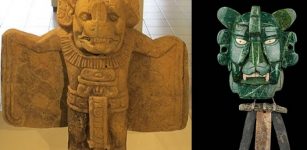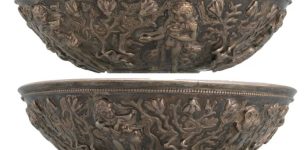Munkholmen: Island With Intriguing Yet Dark And Scary History
Ellen Lloyd - AncientPages.com - A place must not be of great size to have a long and rich history. Munkholmen is certainly proof of that. Located in the Trondheim fjord, Norway, Munkholmen is today a beautiful small island and a popular tourist destination. However, this was by no means the case in the past.
Olav Tryggvason becomes king of Norway. Painting 1860 - credit: Peter Nicolai Arbo (1831–1892)
Visiting Munkholmen was something most wanted to avoid at all costs. The small island has a very intriguing yet dark and scary history.
Heads On Stakes As Warning To Enemies
Before the 12th century, Munkholmen was used as the Court. of Justice. It was also the central place for execution. Heads of enemies of the state were placed on stakes as a warning to potential enemies. Among them were also heads of Haakon Sigurdsson and Tormod Kark to warn visitors. It happened by order of the Viking King of Norway, Olav Tryggvason.
According to legends, those who visited the island must spit on the heads to pay tribute to King Olav Tryggvason. The tradition of displaying severed heads on stakes continued for some years. What changed was that the heads of criminals and political enemies were placed to face the city of Trondheim instead.
It was considered an efficient method to deter citizens from committing crimes.
One Of The First Monasteries In Scandinavia
Later, a monastery was established on Munkholmen, but who came up with the idea is a question of historical disagreement.
Munkholmen fortress, in the Trondheim Fjord, Norway. Image source
According to English sources, King Cnut the Great established the monastery in 1028.
Suppose we rely on Norwegian and Icelandic sources. In that case, we learn that it was one of Magnus Berrfot's men, Sigurd Ullstrengson, the founder of Holm (Nidarholm) monastery in the early 12th century. This monastery was part of the Cluniac order and worshipped Saint Benedict and Saint Lawrence.
With a monastery on the island, one would think the bloody history of Munkholmen had ended. However, this was not the case.
The island continued to be used for keeping prisoners. King of Norway Magnus IV Sigurdsson (ca. 1115-1139), also known as Magnus the Blind, was captured and placed on Munkholmen as a prisoner between 1135 and 1137. Later, he joined the monastery as a monk.
A lighthouse was later built. Image credit: Aslak Raanes from Trondheim, Norway - CC BY 2.0
The monastery on Munkholmen was one of the first monasteries in the Nordic countries. However, it was damaged by fire on several occasions in 1216, 1317, and 1531.
Sometimes, people who tried to escape the prosecution of the Reformation fled to Munkholmen and hid in the monastery, but they always had to surrender in the end.
An Impressive Fortress
Following the Swedish siege of Trondheim in 1658 and the city's reconquest by Danish and Norwegian troops the following year, a fortress was erected on Munkholmen.
The fortress was completed in 1707, and much of it has survived until today.
In the 17th and 18th centuries, the island was used as a State Prison.
Munkholmen Image credit: Trondheim
Those who were transported to Munkholmen were, in most cases, political prisoners. The most famous who served time here was Peder Griffenfeld, a Danish statesman who was imprisoned on Munkholmen for 18 years. Urban legends tell the ghosts of those who died still haunt this place.
Today, when you set foot on the island, you will find a lovely beach, a restaurant, and a café, but the place is of great historical importance, and one is constantly reminded of the events that took place there.
Written by Ellen Lloyd – AncientPages.com
Updated on August 23, 2023
Copyright © AncientPages.com All rights reserved. This material may not be published, broadcast, rewritten or redistributed in whole or part without the express written permission of AncientPages.com
More From Ancient Pages
-
 Reliefs And Engravings Of Celestial Bodies And A Zodiac On Walls And Ceilings Of Luxor’s Esna Temple
Archaeology | Oct 5, 2023
Reliefs And Engravings Of Celestial Bodies And A Zodiac On Walls And Ceilings Of Luxor’s Esna Temple
Archaeology | Oct 5, 2023 -
 3,000-Year-Old Twisted Gold Torc Discovered In Essex
Archaeology | Jul 15, 2023
3,000-Year-Old Twisted Gold Torc Discovered In Essex
Archaeology | Jul 15, 2023 -
 Cog Stones – Unusual Stone Discs Made By An Ancient Lost Civilization In California
Artifacts | Jan 4, 2018
Cog Stones – Unusual Stone Discs Made By An Ancient Lost Civilization In California
Artifacts | Jan 4, 2018 -
 Who Were The Ancient Maya Bat People?
Featured Stories | Jul 13, 2021
Who Were The Ancient Maya Bat People?
Featured Stories | Jul 13, 2021 -
 Why Were Medieval People Easily Offended And Scared Of Rumors?
Ancient History Facts | Oct 14, 2019
Why Were Medieval People Easily Offended And Scared Of Rumors?
Ancient History Facts | Oct 14, 2019 -
 Mysterious Ancient Shapeshifters Who Guided Humans And The Battle Of The Gods Described In Sacred Texts And Myths
Featured Stories | Oct 27, 2021
Mysterious Ancient Shapeshifters Who Guided Humans And The Battle Of The Gods Described In Sacred Texts And Myths
Featured Stories | Oct 27, 2021 -
 Mystery Of The Maya Blue Pigment And Its Unusual Chemical Composition
Ancient History Facts | Mar 23, 2016
Mystery Of The Maya Blue Pigment And Its Unusual Chemical Composition
Ancient History Facts | Mar 23, 2016 -
 Surprising Discovery Reveals Ancient Tibetan Bowl Shows Alexander The Great – The Jewish Version And Not The Homer’s Iliad
Archaeology | Apr 28, 2022
Surprising Discovery Reveals Ancient Tibetan Bowl Shows Alexander The Great – The Jewish Version And Not The Homer’s Iliad
Archaeology | Apr 28, 2022 -
 Mysterious Otherworldly Creatures Witnessed By Biblical Prophet – What Happened?
Biblical Mysteries | Jun 30, 2020
Mysterious Otherworldly Creatures Witnessed By Biblical Prophet – What Happened?
Biblical Mysteries | Jun 30, 2020 -
 On This Day In History: King Louis XVI Of France Was Put On Trial For Treason – On Dec 11, 1792
News | Dec 11, 2016
On This Day In History: King Louis XVI Of France Was Put On Trial For Treason – On Dec 11, 1792
News | Dec 11, 2016 -
 Ptolemaic-Era Warship Discovered Near The Sunken City Of Heracleion In Alexandria By Underwater Archaeologists
Archaeology | Jul 20, 2022
Ptolemaic-Era Warship Discovered Near The Sunken City Of Heracleion In Alexandria By Underwater Archaeologists
Archaeology | Jul 20, 2022 -
 Alexander The Great And The Prophecy Of The Tree Of The Sun And Moon
Featured Stories | Jun 10, 2019
Alexander The Great And The Prophecy Of The Tree Of The Sun And Moon
Featured Stories | Jun 10, 2019 -
 How Did Vikings Worship Their Gods?
Ancient History Facts | May 25, 2016
How Did Vikings Worship Their Gods?
Ancient History Facts | May 25, 2016 -
 Mysterious Books From The Unknown And ‘Impossible’ Coincidences
Featured Stories | Dec 30, 2020
Mysterious Books From The Unknown And ‘Impossible’ Coincidences
Featured Stories | Dec 30, 2020 -
 Rare Iron Age Crouch Burial Discovered At The Margate Caves Site In Kent, UK
Archaeology | Mar 8, 2018
Rare Iron Age Crouch Burial Discovered At The Margate Caves Site In Kent, UK
Archaeology | Mar 8, 2018 -
 Mangup-Kale: Spectacular Ancient Cave City Hidden In The Crimean Mountains And Home To The Mysterious Kingdom Of Feodoro
Civilizations | Aug 4, 2015
Mangup-Kale: Spectacular Ancient Cave City Hidden In The Crimean Mountains And Home To The Mysterious Kingdom Of Feodoro
Civilizations | Aug 4, 2015 -
 Megalithic Giant Tripolye ‘Mega-Structures’ In Large Settlements That Collapsed Around 3650 BC
Archaeology | Oct 1, 2019
Megalithic Giant Tripolye ‘Mega-Structures’ In Large Settlements That Collapsed Around 3650 BC
Archaeology | Oct 1, 2019 -
 First Genome-Wide Ancient Human DNA From Sudan Shines New Light On Nile Valley Past
Archaeology | Dec 20, 2021
First Genome-Wide Ancient Human DNA From Sudan Shines New Light On Nile Valley Past
Archaeology | Dec 20, 2021 -
 Beware Of The Night Marchers – Deadly Ghosts Of Warriors Who Kill With Just One Look
Featured Stories | Jul 23, 2019
Beware Of The Night Marchers – Deadly Ghosts Of Warriors Who Kill With Just One Look
Featured Stories | Jul 23, 2019 -
 On This Day In History: Moscow Armistice Signed Between Finland And Soviet Union – On Sep 19, 1944
News | Sep 19, 2016
On This Day In History: Moscow Armistice Signed Between Finland And Soviet Union – On Sep 19, 1944
News | Sep 19, 2016




